Fluid/Fluid Interfacial Areas Measured for Different Non-Wetting/Wetting Fluid Pairs in Natural Porous Media
Abstract
1. Introduction
2. Materials and Methods
2.1. Materials
2.2. Methods
2.3. Synchrotron X-Ray Microtomography and Data Processing
3. Results and Discussion
4. Conclusions
Author Contributions
Funding
Data Availability Statement
Acknowledgments
Conflicts of Interest
References
- Araujo, J.B.; Brusseau, M.L. Assessing XMT-measurement variability of air-water interfacial areas in natural porous media. Water Resour. Res. 2020, 56, e2019WR025470. [Google Scholar]
- Brusseau, M.L.; Peng, S.; Schnaar, G.; Costanza-Robinson, M.S. Relationships among air-water interfacial area, capillary pressure, and water saturation for a sandy porous medium. Water Resour. Res. 2006, 42, W03501. [Google Scholar]
- Brusseau, M.L.; Peng, S.; Schnaar, G.; Murao, A. Measuring air-water interfacial areas with X-ray microtomography and interfacial partitioning tracer tests. Environ. Sci. Technol. 2007, 41, 1956–1961. [Google Scholar] [CrossRef]
- Brusseau, M.L.; Araujo, J.B.; Narter, M.; Marble, J.C.; Bigler, M. Microtomographic measurements of total air-water interfacial areas for soils. Water Resour. Res. 2024, 60, e2023WR036039. [Google Scholar]
- Costanza-Robinson, M.S.; Harrold, K.H.; Lieb-Lappen, R.M. X-ray microtomography determination of air-water interfacial area-water saturation relationships in sandy porous media. Environ. Sci. Technol. 2008, 42, 2949–2956. [Google Scholar]
- Culligan, K.A.; Wildenschild, D.; Christensen, B.S.B.; Gray, W.; Rivers, M.L.; Tompson, A.F.B. Interfacial area measurments for unsaturated flow through a porous medium. Water Resour. Res. 2004, 40, W12413. [Google Scholar] [CrossRef]
- Willson, C.S.; Lu, N.; Likos, W.J. Quantification of grain, pore, and fluid microstructure of unsaturated sand from X-ray computed tomography images. Geotech. Test. J. 2012, 35, 911–923. [Google Scholar] [CrossRef]
- Schnaar, G.; Brusseau, M.L. Pore-scale characterization of organic immiscible-liquid Morphology in natural porous media using synchrotron X-ray microtomography. Environ. Sci. Technol. 2005, 39, 8403–8410. [Google Scholar]
- Al-Raoush, R.I. Impact of wettability on pore-scale characteristics of residual nonaqueous phase liquids. Environ. Sci. Technol. 2009, 43, 4796–4801. [Google Scholar] [CrossRef] [PubMed]
- Al-Raoush, R.I. Experimental investigation of the influence of grain geometry on residual NAPL using synchrotron microtomography. J. Contam. Hydrol. 2014, 159, 1–10. [Google Scholar] [CrossRef] [PubMed]
- Al-Raoush, R.; Willson, C.S. A pore-scale investigation of a multiphase porous media system. J. Contam. Hydrol. 2005, 77, 67–89. [Google Scholar] [CrossRef] [PubMed]
- Booth, J.M.; Tick, G.R.; Akyol, N.H.; Greenberg, R.R.; Zhang, Y. Experimental comparison of agent-enhanced flushing for the recovery of crude oil from saturated porous media. J. Contam. Hydrol. 2019, 226, 103504. [Google Scholar] [CrossRef] [PubMed]
- Brusseau, M.L.; Janousek, H.; Murao, A.; Schnaar, G. Synchrotron X-ray microtomography and interfacial partitioning tracer test measurements of NAPL-water interfacial areas. Water Resour. Res. 2008, 44, W01411. [Google Scholar] [CrossRef] [PubMed]
- Brusseau, M.L.; Narter, M.; Schnaar, S.; Marble, J. Measurement and Estimation of Organic-liquid/Water Interfacial Areas for Several Natural Porous Media. Environ. Sci. Technol. 2009, 43, 3619–3625. [Google Scholar] [CrossRef]
- Culligan, K.A.; Wildenschild, D.; Christensen, B.S.B.; Gray, W.; Rivers, M.L. Pore-scale characteristics of multiphase flow in porous media: A comparison of air-water and oil-water experiments. Adv. Water. Resour. 2006, 29, 227–238. [Google Scholar] [CrossRef]
- Ghosh, J.; Tick, G.R. A pore scale investigation of crude oil distribution and removal from homogeneous porous media during surfactant-induced remediation. J. Contam. Hydrol. 2013, 155, 20–30. [Google Scholar] [CrossRef]
- Ghosh, J.; Tick, G.R.; Akyol, N.H.; Zhang, Y. A pore-scale investigation of heavy crude oil trapping and removal during surfactant-enhanced remediation. J. Contam. Hydrol. 2019, 223, 103471. [Google Scholar] [CrossRef]
- Hu, Y.; Zhang, C.; Patmonoaji, A.; Shea, Y.; Matsushita, S.; Suekane, T. Pore-scale investigation of wettability impact on residual Nonaqueous phase liquid dissolution in natural porous media. Sci. Total. Environ. 2021, 787, 147406. [Google Scholar] [CrossRef]
- Johns, M.L.; Gladden, L.F. Surface-to-volume ratio of gaglia trapped in small-pore systems determined by pulsed-field gradient nuclear magnetic resonance. J. Colloid Interface Sci. 2001, 238, 96–104. [Google Scholar] [CrossRef]
- McDonald, K.; Carroll, K.C.; Brusseau, M.L. Comparison of fluid-fluid interfacial areas measured with X-ray microtomography and interfacial partitioning tracer tests for the same samples. Water Resour. Res. 2016, 52, 5393–5399. [Google Scholar] [CrossRef]
- Narter, N.; Brusseau, M.L. Comparison of interfacial partitioning tracer test and high-resolution microtomography measurements of fluid-fluid interfacial areas for an ideal porous medium. Water Resour. Res. 2010, 46, W08602. [Google Scholar]
- Porter, M.L.; Wildenschild, D.; Grant, G.; Gerhard, J.I. Measurement and prediction of the relationship between capillary pressure, saturation, and interfacial area in a NAPL-water-glass bead system. Water Resour. Res. 2010, 46, W08512. [Google Scholar] [CrossRef]
- Schnaar, G.; Brusseau, M.L. Characterizing pore-scale dissolution of organic immiscible liquid in natural porous media using synchrotron X-ray microtomography. Environ. Sci. Technol. 2006, 40, 6622–6629. [Google Scholar] [CrossRef]
- Schnaar, G.; Brusseau, M.L. Characterizing pore-scale configuration of organic immiscible liquid in multi-phase systems with synchrotron X-ray microtomography. Vadose Zone J. 2006, 5, 641–648. [Google Scholar] [CrossRef]
- Carroll, K.C.; McDonald, K.; Marble, J.; Russo, A.E.; Brusseau, M.L. The impact of transitions between two-fluid and three-fluid phases on fluid configuration and fluid-fluid interfacial area in porous media. Water Resour. Res. 2015, 51, 7189–7201. [Google Scholar] [CrossRef]
- Zhang, C.Y.; Werth, C.J.; Webb, A.G. A magnetic resonance imaging study of dense nonaqueous phase liquid dissolution from angular porous media. Environ. Sci. Technol. 2002, 36, 3310–3317. [Google Scholar] [CrossRef]
- Fontenot, M.M.; Vigil, R.D. Pore-scale study of nonaqueous phase liquid dissolution in porous media using laser-induced fluroescence. J. Colloid Interface Sci. 2002, 247, 481–489. [Google Scholar] [CrossRef] [PubMed]
- Ovdat, H.; Berkowitz, B. Pore-scale study of drainage displacement under combined capillary and gravity effects in index-matched porous media. Wat. Resour. Res. 2006, 42, W06411. [Google Scholar] [CrossRef]
- Karpyn, Z.T.; Piri, M.; Singh, G. Experimental investigation of trapped oil clusters in a water-wet bead pack using X-ray microtomography. Wat. Resour. Res. 2010, 46, W04510. [Google Scholar] [CrossRef]
- Landry, C.J.; Karpyn, Z.T.; Piri, M. Pore-scale analysis of trapped immiscible fluid structures and fluid interfacial areas in oil-wet and water-wet bead packs. Geofluids 2011, 11, 209–227. [Google Scholar] [CrossRef]
- Rivers, M.L. GSECARS Tomography Software. 2008. Available online: http://cars9.uchicago.edu/software/index.html (accessed on 1 June 2008).
- Ketcham, R.A. Computational methods for quantitative analysis of three-dimensional features in geological systems. Geosphere 2005, 1, 32–41. [Google Scholar] [CrossRef]
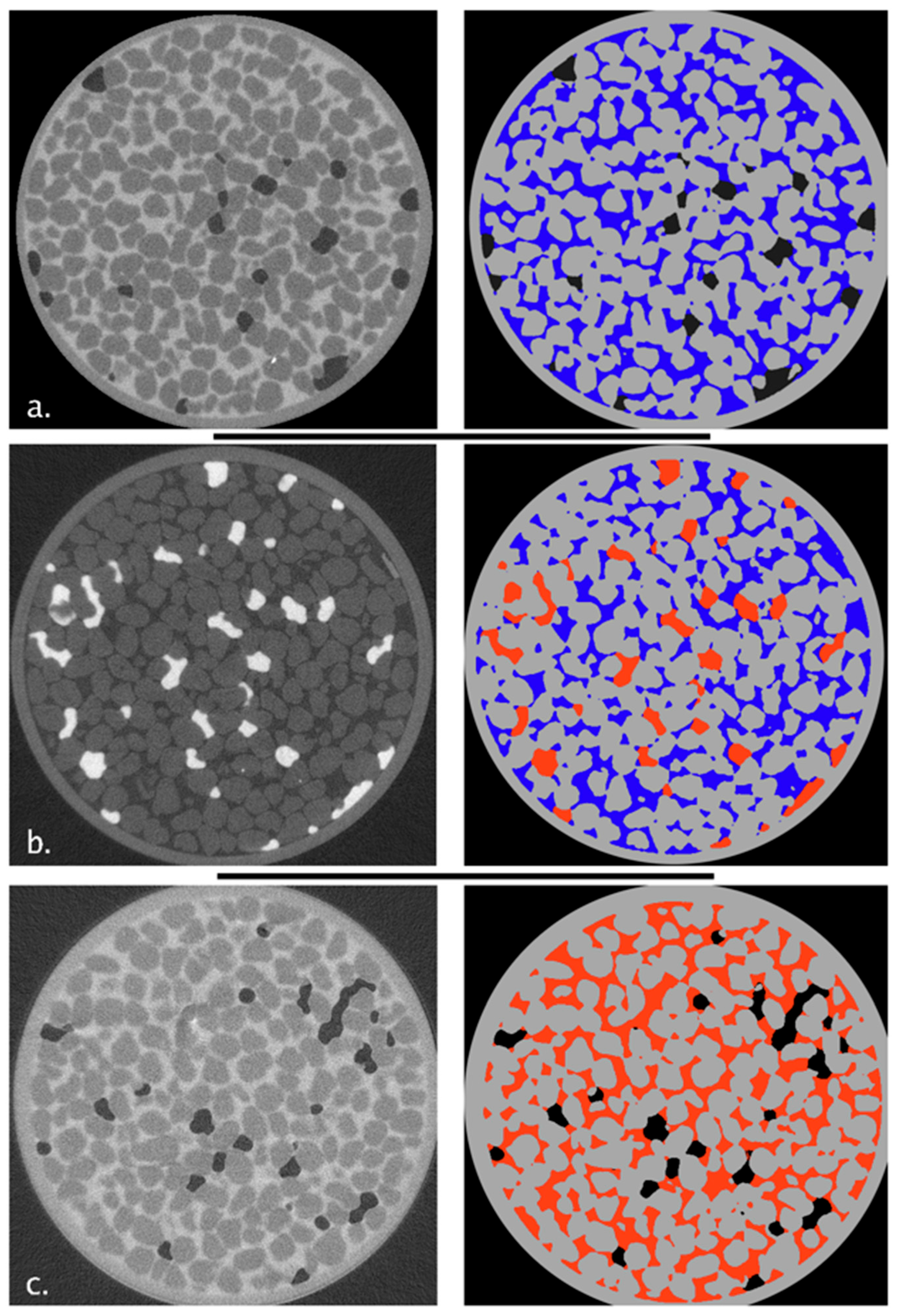
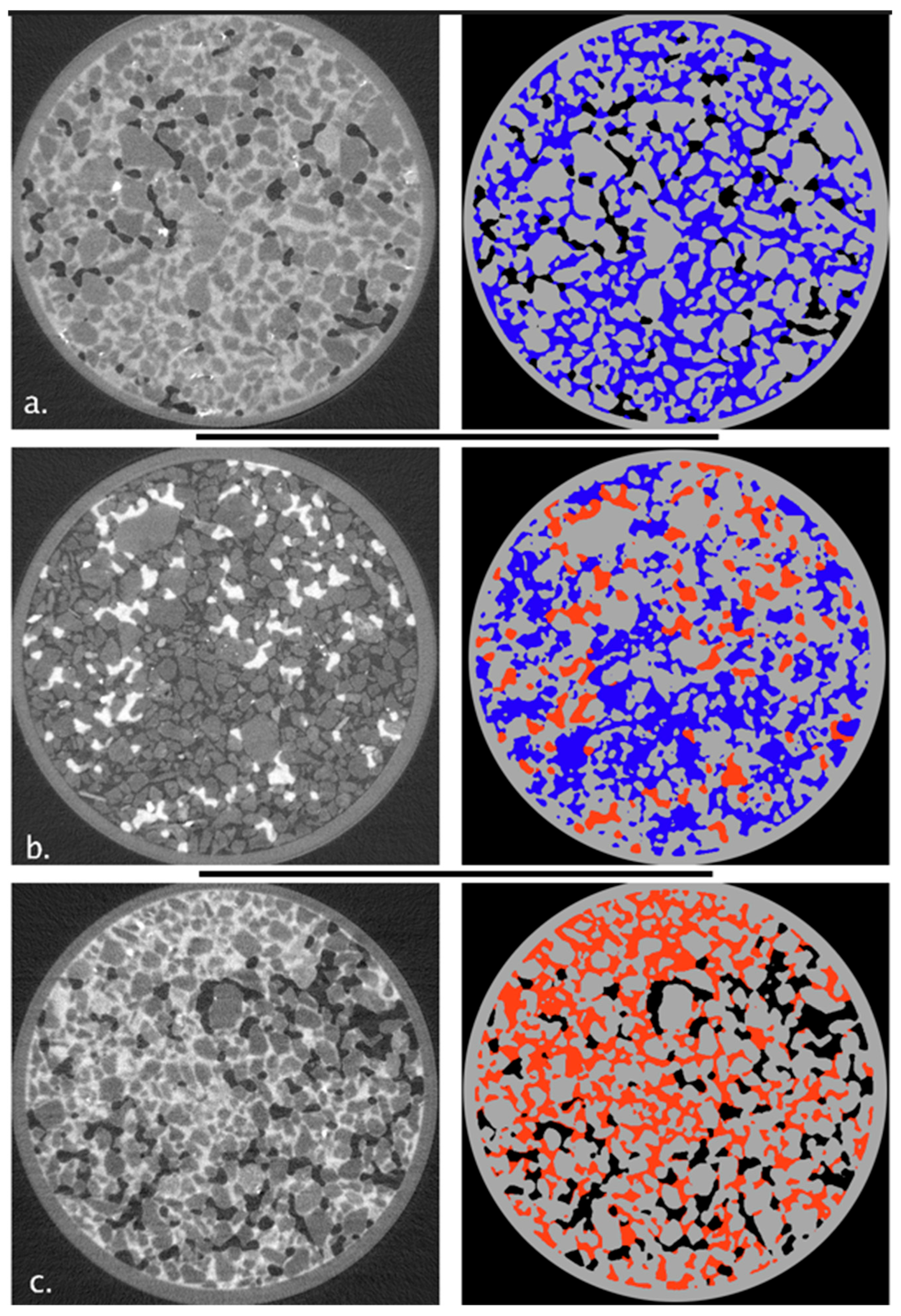
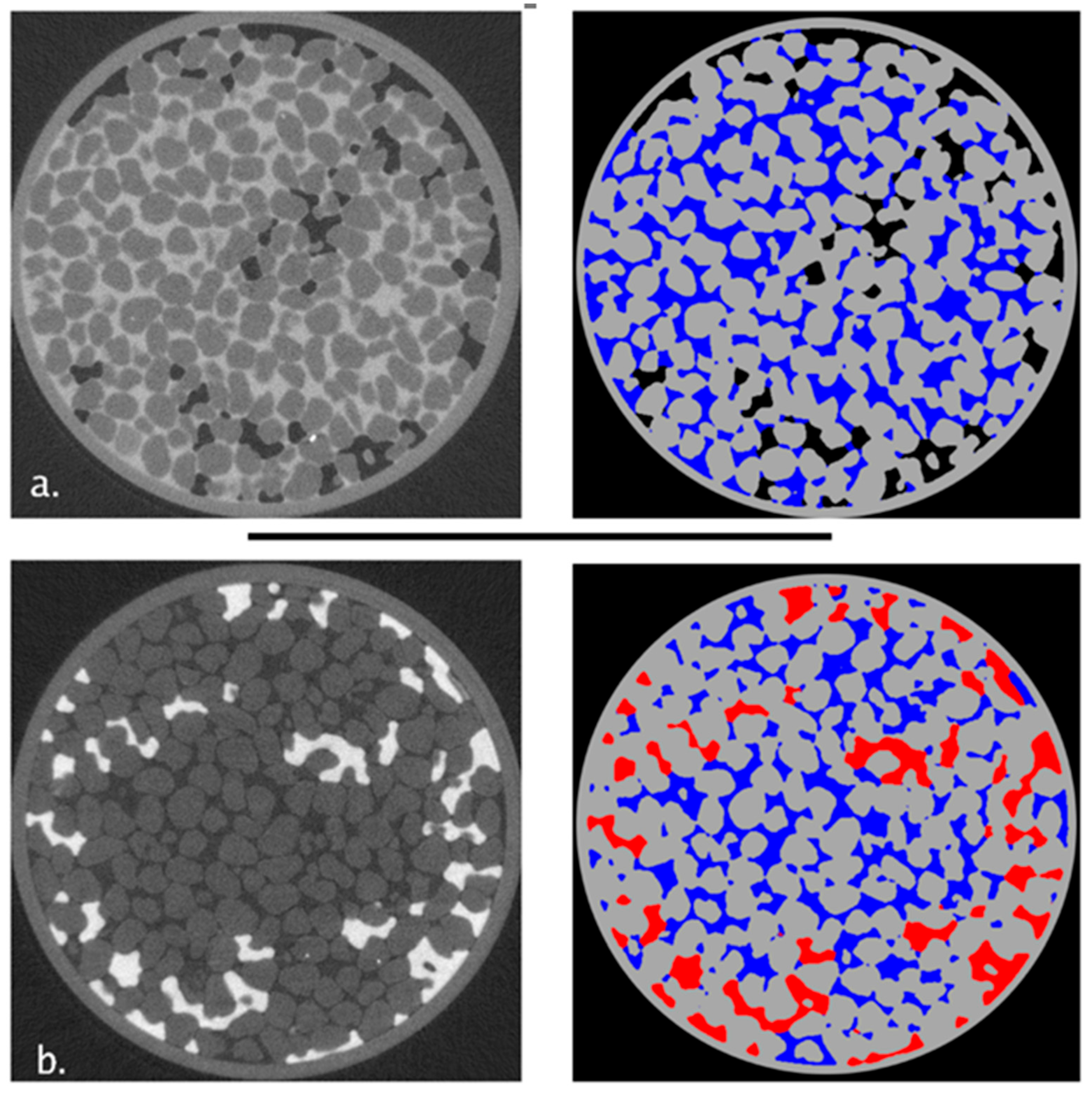
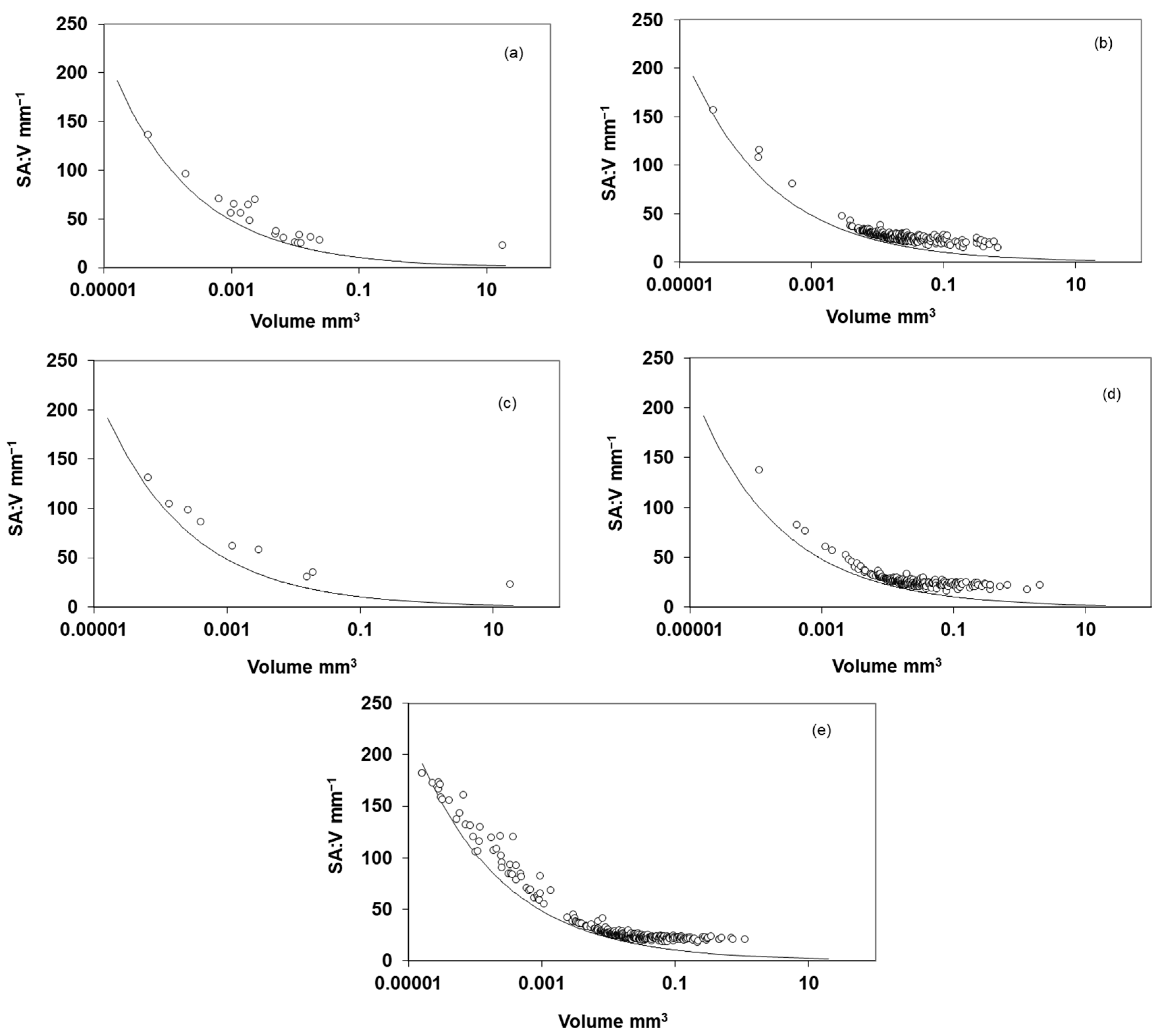
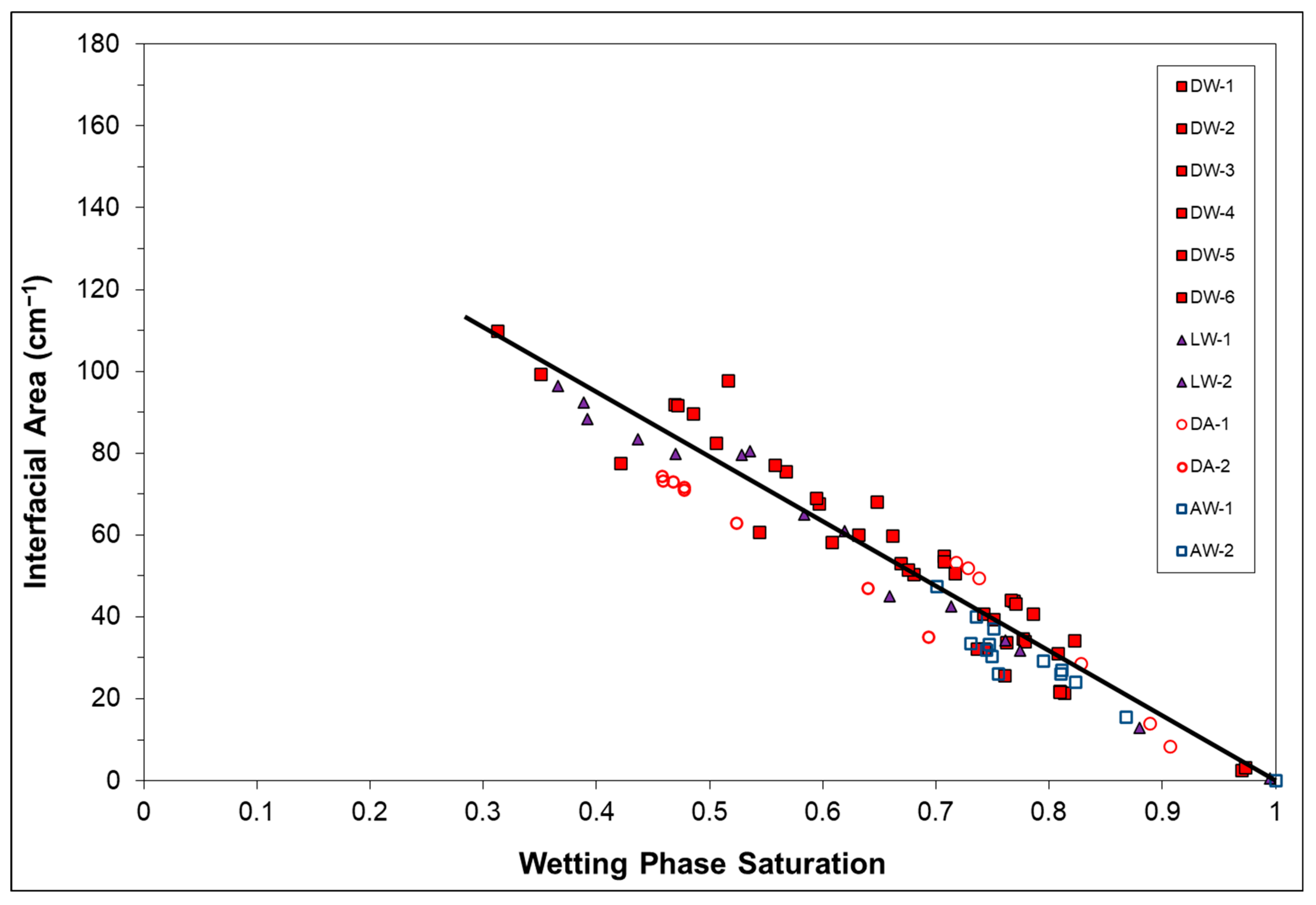
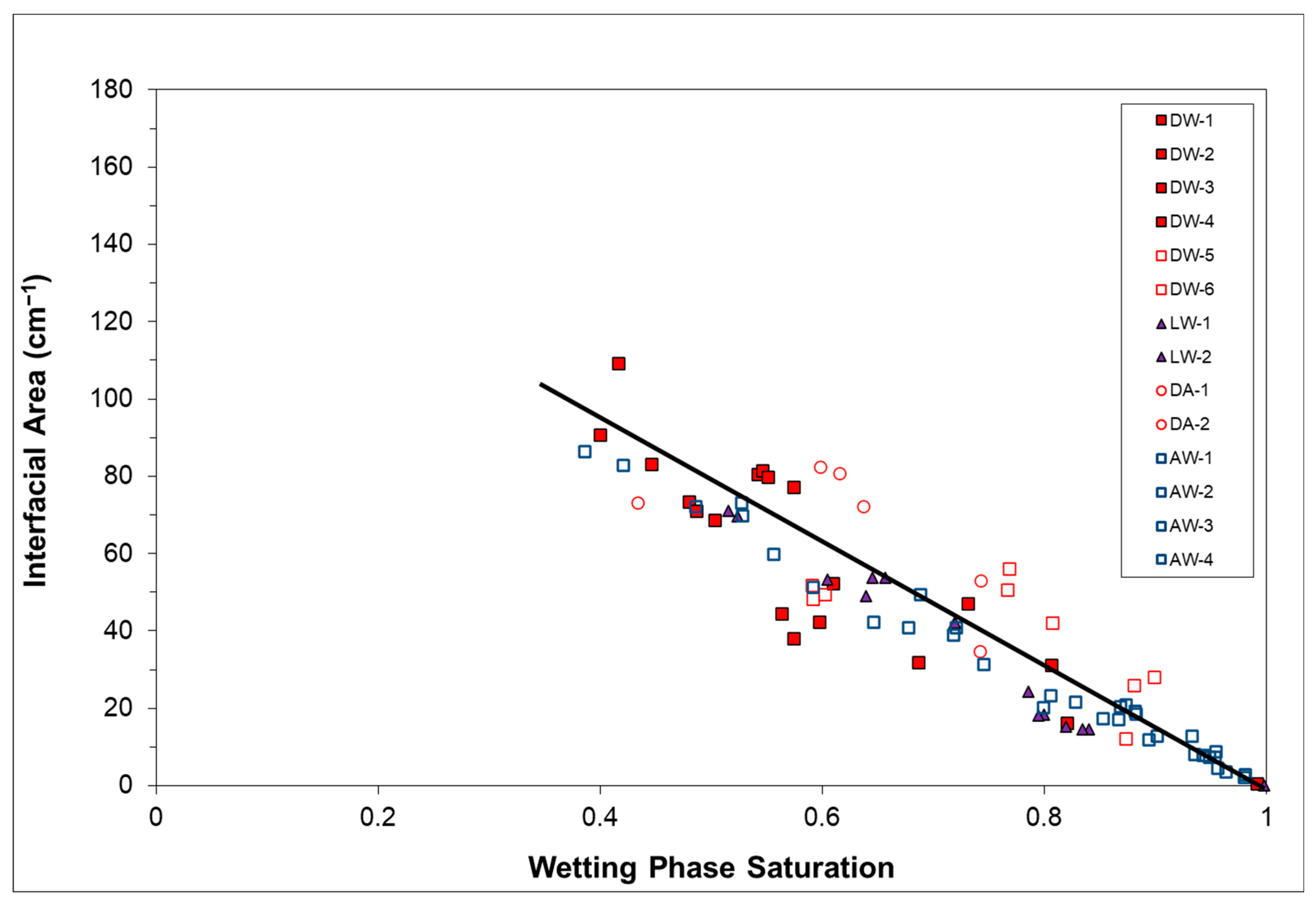
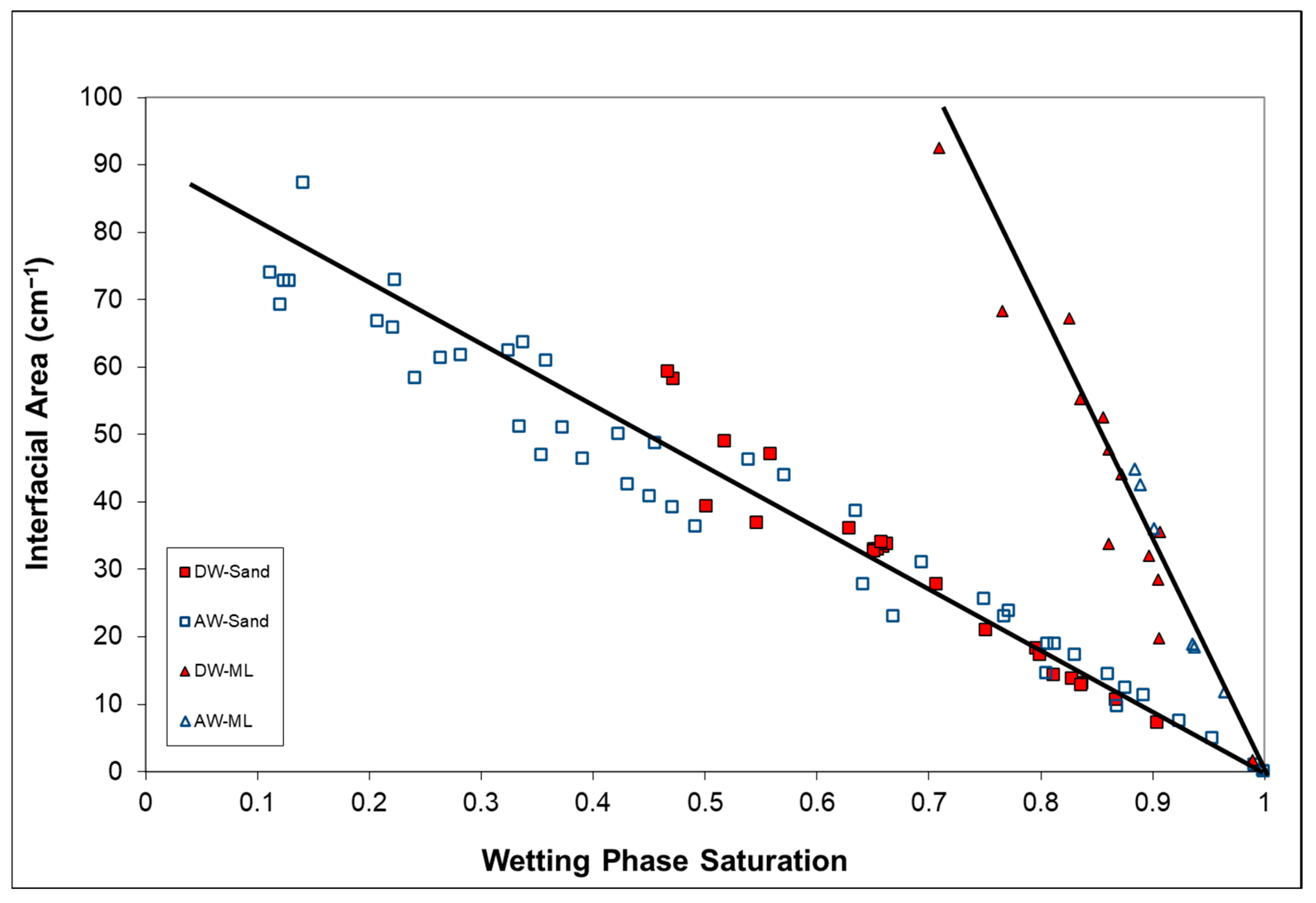
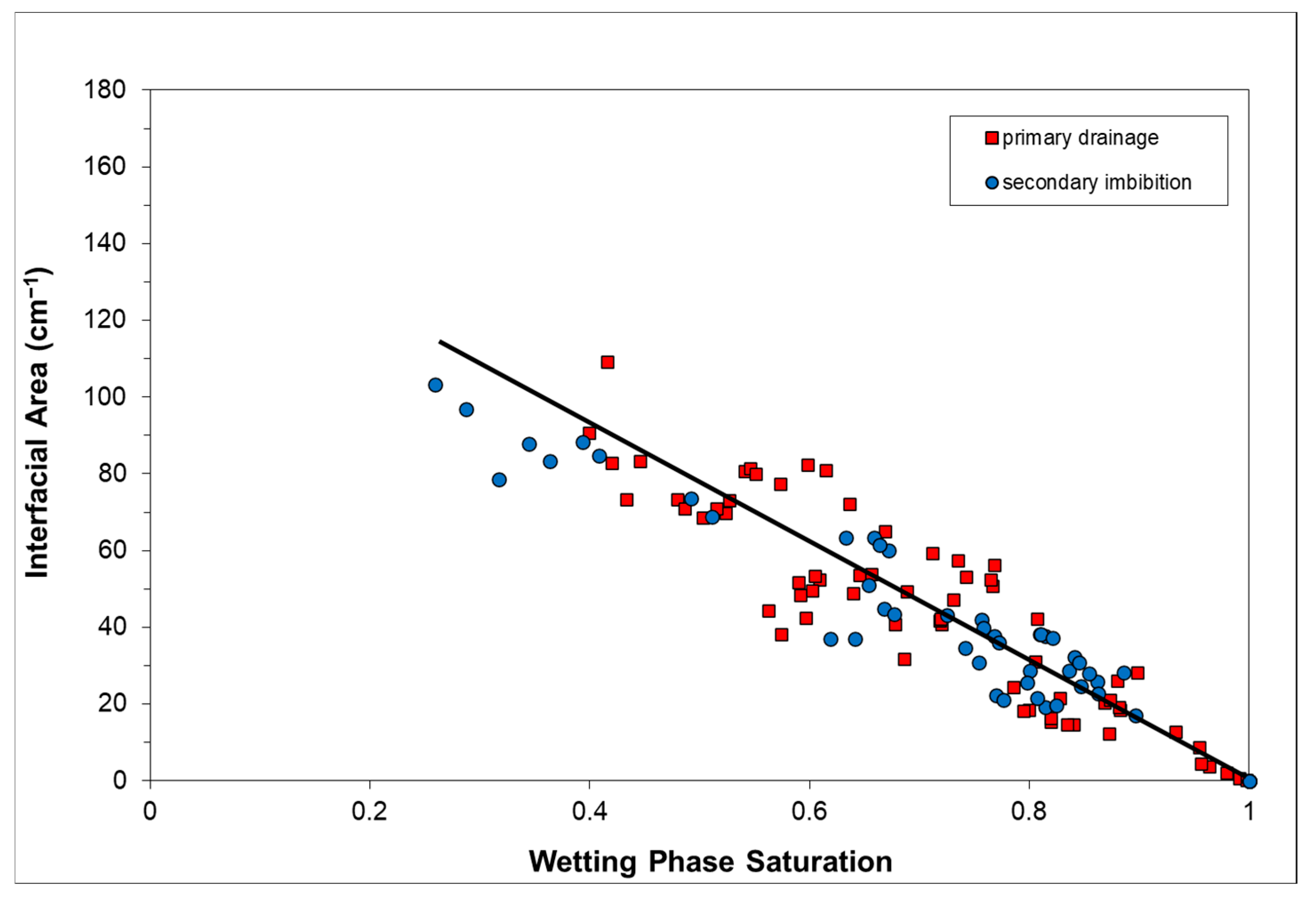
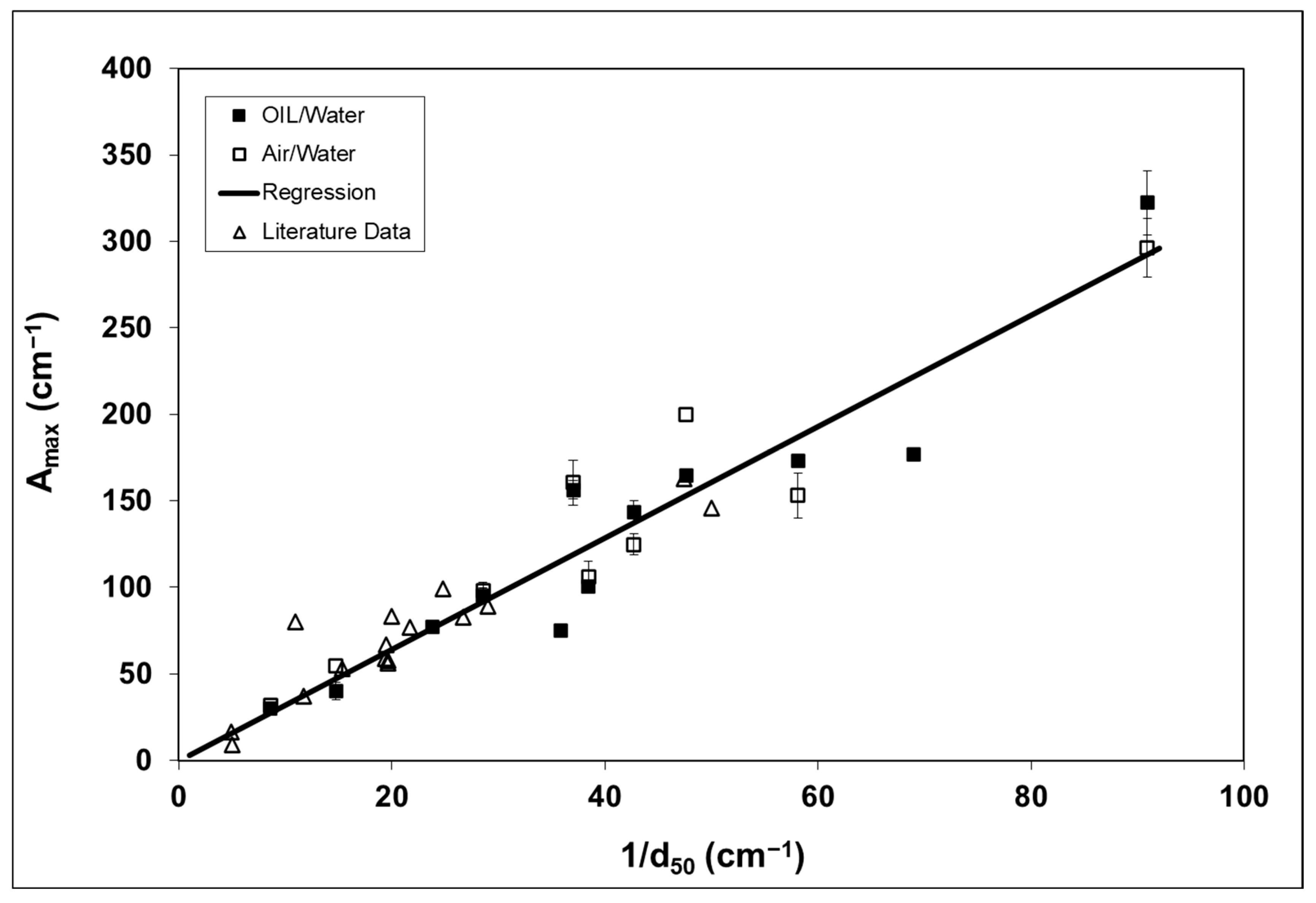
| Fluid Pair | Interfacial Tension | 95% CI |
|---|---|---|
| (dyn/cm) | ||
| Air/Water | 72.9 | 72.3–73.4 |
| Air/Water + 6% CsCl | 74.9 | 73.9–75.9 |
| Air/Water + 13% KI | 74.3 | 72.1–76.6 |
| PCE/Air | 35.6 | 35.1–36.1 |
| PCE + IOB/Air | 36.1 | 35.1–37.1 |
| PCE/Water | 46.2 | 43.6–48.8 |
| PCE + IOB/Water | 42.6 | 41.9–43.3 |
| Porous Medium | Sand% | Silt% | Clay% | Organic Carbon Content% | Bulk Density (g/cm3) | Porosity | Median Grain Diameter d50 (mm) | Uniformity Coefficient (d60/d10) a |
|---|---|---|---|---|---|---|---|---|
| Sand | 100 | 0 | 0 | 0.04 | 1.7 | 0.36 | 0.35 | 1.0 |
| Eustis | 96 | 1.0 | 3.0 | 0.38 | 1.69 | 0.36 | 0.27 | 2.3 |
| Vinton | 97.5 | 1.3 | 1.2 | 0.06 | 1.52 | 0.40 | 0.23 | 2.4 |
| Mt. Lemmon | 60 | 24 | 16 | 10 | 1.17 | 0.48 | 0.11 | 23 |
| Porous Medium | Porosity | Bulk Density (g/cm3) | U a | Median Grain Diameter (d50, mm) | Specific Solid Surface Area (cm−1) b | Number c |
|---|---|---|---|---|---|---|
| Sand—20/30 | 0.39 | 1.63 | 1.2 | 0.677 | 54 | 4, 5 |
| Sand—45/50 | 0.34 | 1.8 | 1.1 | 0.35 | 113 | 5, 12 |
| Sand—70/100 | 0.36 | 1.69 | 1.8 | 0.172 | 222 | 2, 4 |
| Sand—100/140 | 0.37 | 1.66 | 1.7 | 0.145 | 261 | 2, 0 |
| Sand—Mixed | 0.28 | 1.9 | 3.4 | 0.279 | 154 | 2, 0 |
| Hayhook soil | 0.38 | 1.65 | 16 | 0.26 | 144 | 2, 4 |
| Vinton soil | 0.42 | 1.54 | 2.4 | 0.234 | 149 | 9, 7 |
| Eustis soil | 0.38 | 1.65 | 2.3 | 0.27 | 138 | 10, 6 |
| Borden sediment | 0.34 | 1.74 | 1.9 | 0.21 | 189 | 1, 1 |
| Mt. Lemmon soil | 0.56 | 1.17 | 23 | 0.11 | 240 | 6, 2 |
| Glass beads—1 | 0.39 | 1.52 | 1.0 | 0.42 | 87 | 1, 0 |
| Glass beads—2 | 0.44 | 1.28 | 1.0 | 1.0 | 34 | 2, 1 |
| Porous Medium | Non-Wetting/Wetting Fluids a | Number b | Source |
|---|---|---|---|
| Crushed quartz | OIL/water | 4 | [27] |
| Silica gel—1 | OIL/water | 1 | [26] |
| Silica gel—2 | OIL/water | 1 | [26] |
| Glass beads—organic coated | Water/OIL | 1 | [11] |
| Plastic spheres | OIL/glycerol | 8 | [28] |
| Glass beads—1–3 | Air/water | 1 each | [5] |
| Silica sand—1–5 | Air/water | 1 each | [5] |
| Glass beads | OIL/water | 1 | [29] |
| Glass beads | OIL/water | 1 | [22] |
| Plastic spheres | Water/OIL | 1 | [30] |
Disclaimer/Publisher’s Note: The statements, opinions and data contained in all publications are solely those of the individual author(s) and contributor(s) and not of MDPI and/or the editor(s). MDPI and/or the editor(s) disclaim responsibility for any injury to people or property resulting from any ideas, methods, instructions or products referred to in the content. |
© 2025 by the authors. Licensee MDPI, Basel, Switzerland. This article is an open access article distributed under the terms and conditions of the Creative Commons Attribution (CC BY) license (https://creativecommons.org/licenses/by/4.0/).
Share and Cite
Brusseau, M.L.; Narter, M.E.; Schnaar, G.; Araujo, J.; Marble, J. Fluid/Fluid Interfacial Areas Measured for Different Non-Wetting/Wetting Fluid Pairs in Natural Porous Media. Environments 2025, 12, 380. https://doi.org/10.3390/environments12100380
Brusseau ML, Narter ME, Schnaar G, Araujo J, Marble J. Fluid/Fluid Interfacial Areas Measured for Different Non-Wetting/Wetting Fluid Pairs in Natural Porous Media. Environments. 2025; 12(10):380. https://doi.org/10.3390/environments12100380
Chicago/Turabian StyleBrusseau, Mark L., Matthew E. Narter, Gregory Schnaar, Juliana Araujo, and Justin Marble. 2025. "Fluid/Fluid Interfacial Areas Measured for Different Non-Wetting/Wetting Fluid Pairs in Natural Porous Media" Environments 12, no. 10: 380. https://doi.org/10.3390/environments12100380
APA StyleBrusseau, M. L., Narter, M. E., Schnaar, G., Araujo, J., & Marble, J. (2025). Fluid/Fluid Interfacial Areas Measured for Different Non-Wetting/Wetting Fluid Pairs in Natural Porous Media. Environments, 12(10), 380. https://doi.org/10.3390/environments12100380





